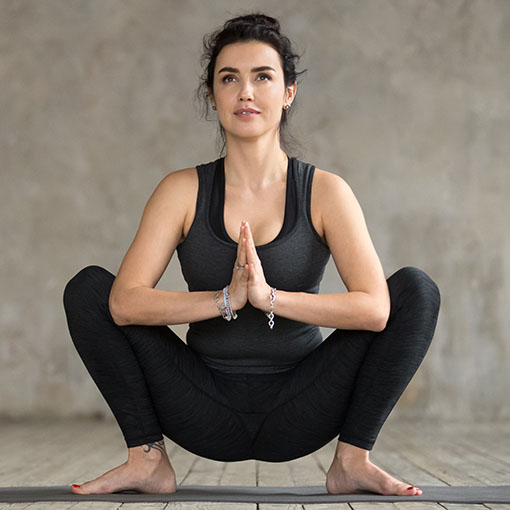
Vinita’s recommended postures for menstrual pain relief
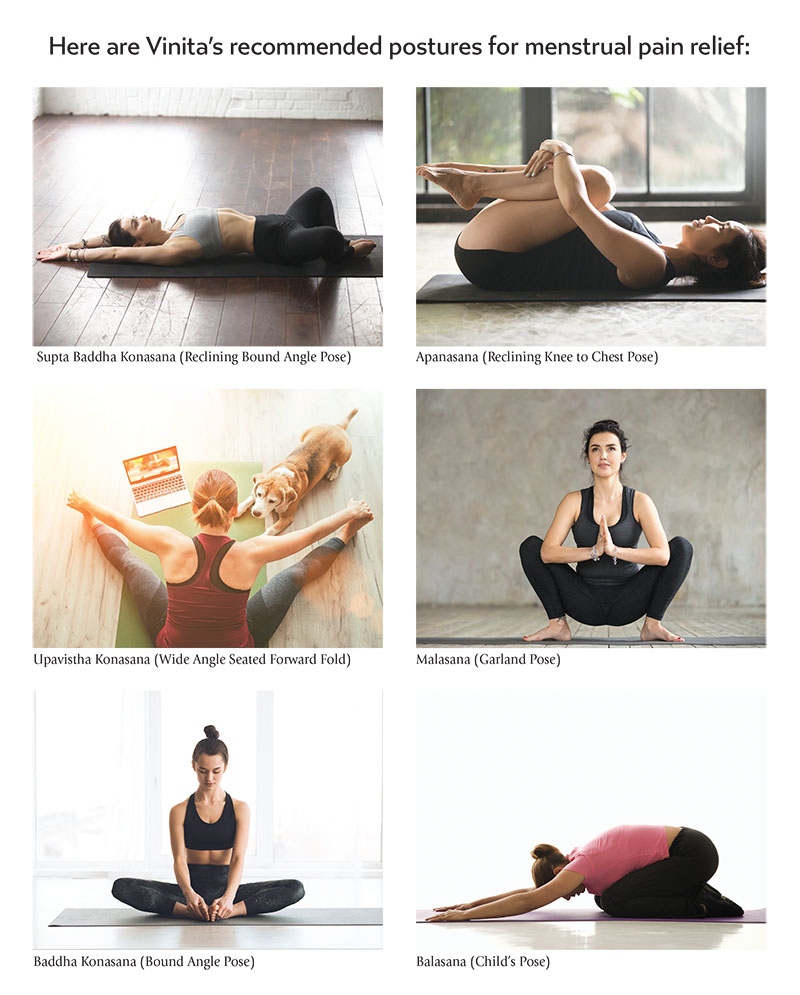


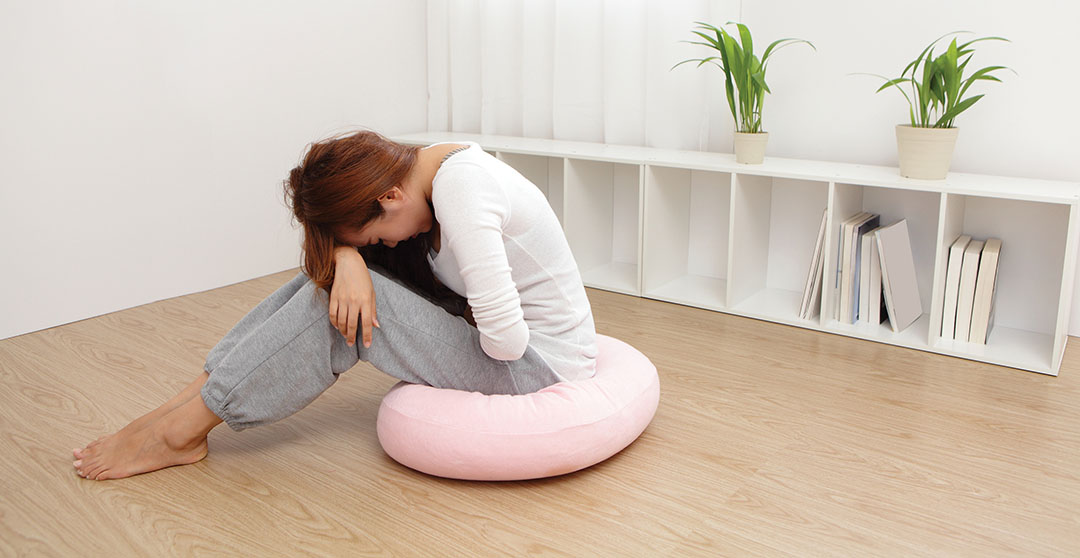
What is dysmenorrhea?
Dysmenorrhea is a medical term that means “painful periods” and unfortunately 50%-90% of menstruating women experience it every month. It’s ironic that such an important and life-giving biological function can have such an agonizing physical and emotional impact on us. There are a number of ways to decrease menstrual pain and to increase quality of life, allowing for a more amicable monthly visit from Aunt Flo.
What causes menstrual cramping?
Dr. Vicky Scott is the founder of Asheville Gynecology and Wellness, an integrative GYN practice in Asheville, N.C. She is board-certified in obstetrics and gynecology, lifestyle medicine, as well as integrative and holistic medicine. She explains that as women get closer to their period the body starts producing prostaglandins, which are inflammatory compounds that cause the uterus to contract and release its lining. This can cause cramping. Cramps can also occur with an imbalance of estrogen and progesterone, particularly when estrogen levels are too high or progesterone levels are too low.
The following are the most common symptoms of dysmenorrhea:
• Cramping and pain in the lower abdomen
• Low back pain
• Pain radiating down the legs
• Nausea
• Vomiting
• Diarrhea
• Fatigue
• Weakness
• Fainting
• Headaches
It is very important to see a gynecologist to address any underlying causes of dysmenorrhea. Other conditions that can cause cramping, pelvic pressure, low back pain, heavy or prolonged periods, and gastrointestinal issues include the following:
Endometriosis is a condition that causes the tissue that usually lines your uterus to grow outside the uterus.
Polycystic ovary syndrome (PCOS) is a common hormone disorder affecting approximately 1 in 10 women of childbearing age. This is when the body tends to produce higher than normal amounts of male hormones. Symptoms include heavy periods, prolonged periods, excessive facial and body hair, weight gain, trouble losing weight, acne, thinning hair, or hair loss.
Fibroids are noncancerous growths that develop inside or outside of the uterus. They range in size from as small as a seed to large masses that can cause an enlarged uterus. The symptoms vary depending on the number of fibroids, their size, and location.
Pelvic inflammatory disease (PID) is a bacterial infection of the female reproductive organs. It’s usually caused by sexually transmitted infections, such as chlamydia and gonorrhea. Symptoms include painful intercourse, bleeding during or after sex, foul-smelling vaginal discharge, burning sensation when urinating, fever, and spotting between periods.
Adenomyosis is a thickening of the uterus. It occurs when the endometrial tissue that lines your uterus grows into the muscles of your uterus and can cause your uterus to grow two to three times its normal size.
An intrauterine device (IUD) is a small birth control device that’s inserted into your uterus. There are different types of IUDs available, some containing hormones while others are hormone-free. They’re safe for most people, but they can occasionally cause side effects, including severe menstrual cramps, irregular periods, and heavy menstrual bleeding.
How to treat painful periods
Non-steroidal anti-inflammatory drugs (NSAIDs), such as ibuprofen, help reduce menstrual pain by inhibiting prostaglandin activity, and reducing inflammation.
Acetaminophen (Tylenol) is another option if NSAIDS fail to work, or upset the stomach.
Hormone therapy such as the birth control pill, skin patches, or a Depo-Provera shot may prevent ovulation and reduce the severity of menstrual cramps. They can also make periods lighter, shorter, and less painful. This is not an option for women who smoke, have a history of blood clots, high blood pressure, or cancer.
Regular exercise increases endorphins which can decrease pain.
A heating pad across the abdomen can help relax the abdominal muscles.
Pelvic floor physical therapy can relieve pelvic floor pain associated with excessive tightening and cramping by helping shortened and contracted muscles to stretch and relax.
A hot bath with aromatherapy oils such as lavender, chamomile, and sage can be soothing.
Give yourself an abdominal massage by placing your hands over your navel. Begin by making small circles in a clockwise direction. This should be done slowly with moderate pressure for about a minute. Then gradually increase the size of the circling until you are rubbing the entire abdomen.
Food as Medicine
Dr. Scott often recommends proper nutrition and dietary changes to support a healthy and pain free menstrual cycle. Foods eaten can either increase the estrogen effect or reduce it. There have been studies that show that women who eat a high fiber and low fat diet have less estrogen levels and less painful cycles. Here are some dietary and lifestyle recommendations from Dr. Scott:
Eat whole grains such as brown rice, whole-grain bread, and oatmeal.
Eat vegetables such as broccoli, spinach, carrots, sweet potatoes, Swiss chard, and Brussels sprouts.
Eat legumes such as beans, peas, and lentils.
Eat fruits such as apples, mangoes, berries, and oranges.
Avoid caffeine, alcohol, and tobacco.
Avoid refined grains such as white bread, refined cereals, and pastries.
Avoid fatty foods such as doughnuts, cheese, French fries, and potato chips.
Reduce stress: psychological stress may increase your risk of menstrual cramps.
Drink herbal teas such as chamomile, ginger, lemon balm, fenugreek, peppermint, and cramp bark which contain anti-inflammatory and antispasmodic compounds.
Supplements such as vitamin E, omega-3 fatty acids, vitamin B-1 (thiamine), vitamin B-6, and magnesium may effectively reduce menstrual cramps.
A Traditional Chinese Medicine Approach
In Chinese medicine, the most common reason for menstrual cramping is because of the stagnation of blood circulation in the lower abdomen. Acupuncture is a safe and effective technique used to increase blood flow, relax contractions, and move stagnation. Researchers at The National Institute of Complementary Medicine at Western Sydney University in Australia conducted a study to compare the efficacy of acupuncture for the treatment of dysmenorrhea. The researchers found that, in all cases, acupuncture led to a significant reduction in the intensity and duration of menstrual pain after three months of treatment.
Yoga as Medicine
Vinita Khatavkar is a seasoned yogi who teaches in the Asheville area. She has been practicing yoga since 1989 and says that regular practice of asanas (yogic postures) and pranayama (breathing techniques) are beneficial for relieving menstrual pain. Every asana can be held for 5 to 6 deep breaths or for a longer duration if it helps with the pain. She notes that inversions such as headstands and shoulder stands, as well as deep twists and backbends, should be avoided while menstruating.
Natasha Kubis is a licensed acupuncturist and certified yoga teacher.
For more information, visit acuwellhealth.com
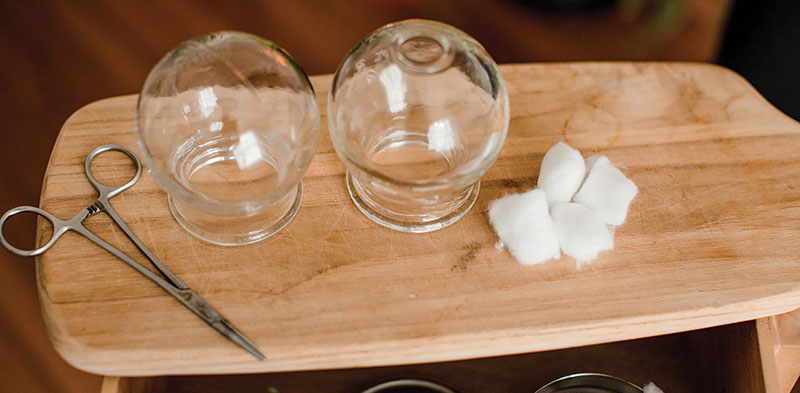
By Natasha Kubis
When Olympic Gold Medalist, Michael Phelps, appeared in photographs sporting red circular marks all over his body, people questioned if he had been in an altercation with an octopus. In recent years, celebrities and athletes alike have brought the ancient art of cupping therapy to the public eye, making it more mainstream than ever before.
Cupping may be trending at the moment but it is in fact a universal therapy practiced by many cultures around the world. It can be traced back to ancient Egyptian, Chinese, and Middle Eastern times, and as early as 1550 BC. It was prescribed for various ailments in the records of Herodotus, Hippocrates, Celsus, and Aretaeus. Its roots can be found in the ancient healing systems of Tibetan, Oriental, and Ayurvedic medicine (traditional Indian medicine), as well as Unani (a South Asian and Middle Eastern folk medicine).
As ancient and widely used as this technique is, it is widely misunderstood in our modern culture and the marks that it leaves on the skin can make people quite apprehensive, understandably so. Having some knowledge about the technique may help transform it into a viable option to treat your aches and pains.
What is cupping used for?
Cupping is effective for relieving pain, relaxing muscle spasms, increasing local blood circulation, and detoxifying local tissues. It can increase range of motion in the joints, and promote flexibility in the ligaments, tendons, and in-between muscle layers. It is most effective for neck, back, knee, and elbow pain, as well as for conditions like tendonitis, sciatica, tension headaches, migraines, fibromyalgia, and arthritis. It can be used for bronchial congestion caused by allergies, asthma, and the common cold.
How does it work?
There are several cupping methods. A traditional technique used by practitioners of Chinese Medicine is called Glass Jar Fire Cupping. The practitioner will light a cotton ball on fire and use it as a heat source to warm the glass cup and to remove the oxygen from inside of it. The cup is then placed on the skin and as the air inside of it cools, a vacuum effect causes the blood vessels to expand and the skin begins to rise.
More modern versions of cupping methods used by massage therapists, physical therapists, chiropractors, or for home use do not use fire, but instead, create the vacuum effect with glass, bamboo, earthenware, or silicon cups that are moved across the skin, or remain stationary.
Is it similar to massage?
Cupping has a similar effect on the body as massage except that cupping uses suction or negative pressure rather than the tissue compression used in massage techniques. The suction stretches the tissues up from the underlying structures, thereby releasing muscle tension and loosening areas of restriction. This creates an expansion of the tissues while increasing blood flow, promoting better functioning of sweat and sebaceous glands, flushing capillary beds, and dispelling stagnation and congestion.
How does it affect the skin?
The suction of the cups often leaves temporary marks on the skin. The marks resemble bruising, but are not painful. They are the result of bringing blood and toxins to the skin’s surface. The color of the marks can range from light pink to dark purple, depending on your condition. The marks can last from about 3 to 10 days. To help reduce this duration, it is recommended to drink plenty of water after your treatment.
Does it hurt?
No, it does not hurt. Most people find it relaxing and feel a warm suction, as though their skin is being lifted.
How many treatments will you need?
The effects of cupping are cumulative and the treatment should be repeated until the ailment is resolved. The severity of the marks will usually diminish with each follow up treatment, indicating that the stagnation in the tissues has decreased.
Are there any risks associated with the technique?
It is important to see a licensed acupuncturist, Doctor of Chinese Medicine, licensed massage therapist, physical therapist, or chiropractor who has been adequately trained in the technique. Do not be shy about asking about their training before booking a session. The risks of cupping are very low with a trained professional who has adequate experience. There are cupping sets available for home use, but it is important to have proper knowledge of safe cupping practices before trying it on yourself or others.
Cupping is contraindicated for those with blood clotting disorders (like deep vein thrombosis or history of stroke), bleeding disorders (such as hemophilia), or those who take blood thinners (such as warfarin). It is not recommended for skin conditions such as allergic dermatitis, psoriasis, or eczema. Cupping is contraindicated in cases of severe diseases such as cardiac failure, renal failure, ascites due to hepato-cirrhosis, and severe edema. Cupping should not be applied over broken bones, dislocations, hernias, and should not be used on the low back or abdomen during pregnancy.
The Takeaway
Cupping is a wonderful option to help ease pain and inflammation, increase blood flow, promote relaxation and well-being by calming the nervous system, aid in detox, and provide a deep-tissue massage. The cupping marks also make for a good story when wearing a bathing suit or a strapless dress!
Natasha Kubis is a licensed acupuncturist and certified yoga teacher.
For more information, visit acuwellhealth.com

Trish Luzzi has been on the back of a motorcycle since she was 16 years old. Her love of freedom and exploration has given her the reputation of being a gypsy among her family and friends. Her openness to adventure is what led her from Canada to the United States to pursue her career in the media and real estate industries. She is passionate about encouraging others to take chances and follow their dreams. Helping people achieve their goals is what makes her the dedicated, determined, and savvy real estate advisor that she is today.
Trish has a great team of professionals at Engel & Völkers, and she feels blessed to work with Bethany Behrmann, their amazing broker in charge, who guides and encourages the team daily in their professional careers. Trish has lots of personal experience with buying and selling homes which motivated her to get her real estate license in 2018. Real estate is a way for Trish to help people settle down and get to where they want to be on their journeys. She wears many hats in the industry and enjoys both sides of a real estate transaction, whether that be selling someone’s home or finding them their next dream home.
To Trish, it’s not just about the brick and mortar of the home. It’s about going that extra mile for her clients. That can mean getting her hands dirty in crawl spaces and attics, understanding water and radon testing, being knowledgeable about septic systems and wells, and establishing trusting friendships with her clients. She goes above and beyond to make sure all the details are taken care of and her client can feel at ease throughout the process. She is able to get the resources her clients need so that they don’t have to sweat the small stuff. For instance, Trish had some out-of-state clients who purchased a home, but were not moving into the home for several months. Trish would check on their house every week and pick up their mail. Trish embodies everything you could want in a real estate advisor. She has keen negotiation skills, she’s detail oriented, a great problem solver, and to top it all off, she has a fun loving and charismatic personality.
Trish and her partner, Jim, also co-own Aero Property Investors where they work with people who want to get into the real estate game, but don’t want to handle all the aspects of property management and house flipping. Their company’s goal is to maximize their client’s funds by helping them invest in local and affordable real estate. They also work with realtors and clients to clear out homes in preparation for closings.
Trish’s journey began in Hamilton, Ontario, where she served as the Community Relations Representative for the McDonald’s Corporation. One of the greatest achievements of her career was serving on the board of directors to build a Ronald McDonald House in her home town. While raising money for the project, she met Don Luzzi, her future father-in-law and mentor, and the person that catalyzed her career in the media industry. Don was the president of two radio stations in Hamilton & Toronto and Trish was impressed by his sharp negotiating skills, cleverness, and refined business sense. She knew from their first meeting that she wanted to work for him and had asked him for a job at his station. After a few years of working for different radio stations, Don hired her at his station for sales and marketing. His integrity and leadership skills separated him from the rest of the pack and the skills Trish learned from him early on in her career left a lasting mark on her for years to come. She has been divorced from her ex-husband for a long time, but she continues to remain close to Don, and he continues to be one of her closest advisors.
Trish’s own father passed away when she was just a little girl, and her mother taught her and her siblings to always be strong willed and autonomous. When Trish went through difficult times in her life, her family reminded her to stay true to her independent, spontaneous, and adventurous spirit. This sentiment is what inspired her to get her motorcycle license. She was determined to be the driver of her own destiny, not just a passenger along for the ride.
Trish’s sense of adventure led her from Canada to the United States, where she became a permanent resident and lived in Florida and Connecticut, eventually settling down in North Carolina. She has managed teams of account executives whose focus was helping realtors market themselves in the digital world. She also worked with big companies such as Sotheby’s and Coldwell Banker to assist them in utilizing their marketing dollars to attract buyers and sellers. While living in Connecticut, she became the Senior Director of Sales Operations for Hearst Connecticut Media.
Trish had always been determined to move to the Carolinas and when she met her partner, Jim Fritz, they were able to make that dream a reality. Trish and Jim share a love of adventure and motorcycles, so the winding and scenic mountain roads of Western North Carolina were a major draw for them. “It doesn’t take much of a nudge from either of us to drop what we are doing and go for a ride any month of the year.” A typical ride for them lasts from 3 to 10 hours and they can end up in another state just to go to lunch.“We have covered all of the Northeast, including New York, Connecticut, New Jersey, Massachusetts, Maine, and Vermont. Our best trip so far, was a 6-day trip from Connecticut to the Cabot Trail in Nova Scotia with a group of friends.” Her true home is on a bike, boat, or a horse, and is where she finds her ultimate peace of mind. Tragedy struck when Trish had a bad car accident a few years ago and she found herself apprehensive about getting back on her bike. With the support and encouragement of Jim, she is determined to get back to riding and becoming that adventurous free spirit once again.
Trish hasn’t let go of her media background and is also an account executive for AVL Media Inc. and does freelance work for SOFIA magazine. She is proud to be a part of the publication because it focuses on local business women and has featured some great gals on the cover, many of whom she works with in her industry.
On a personal level, Trish is super optimistic and there is no place for negativity in her world. She can always find the good in any situation. While she strives to be the best version of herself, she knows it’s also important, especially for women, to love ourselves the way we are, and be comfortable in our own skin in order to truly give to others and to be of service. She is a Rotarian with the Hendersonville Rotary Club and some of her major goals for 2021 include completing 30 charitable activities (she has a food drive set up in her neighborhood for Manna food bank in February), as well as taking 30 hikes, and 30 motorcycle rides.
Trish Luzzi
Real Estate Advisor
ENGEL & VÖLKERS Asheville
[email protected]
trishluzzi.evrealestate.com
828-423-0248
Natasha Kubis is a licensed acupuncturist and certified yoga teacher.
For more information, visit acuwellhealth.com
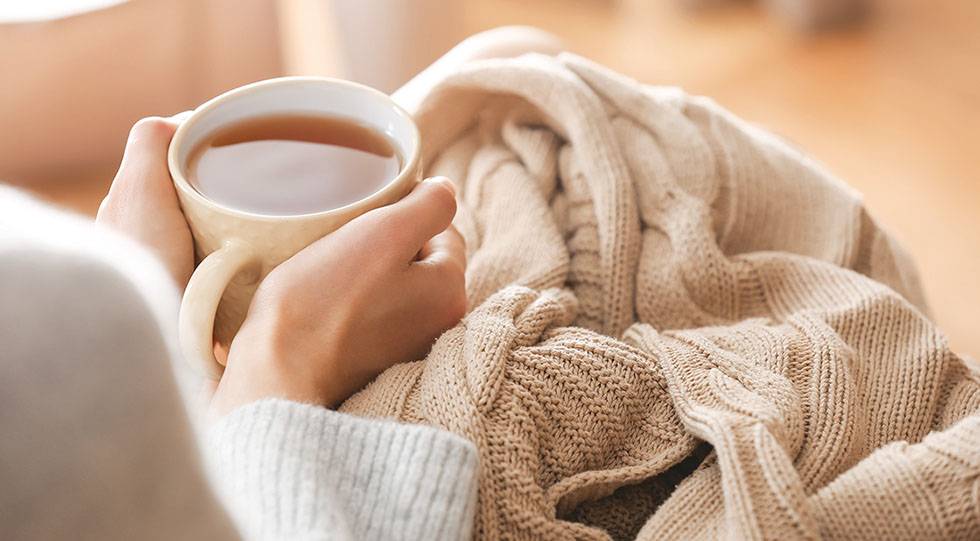
By Natasha Kubis
Next to water, tea is the most commonly consumed drink around the world. It is deeply integrated into many cultures because of its abilities to bring people together, to soothe the soul, to please the senses, to elevate the mind, and to heal the body.
“No matter where you are in the world, you are at home when tea is served.” – Earlene Grey
I will never forget my experience with Moroccan hospitality while traveling through that enchanting country. Every person I met along the way was eager to help and connect, even when language was a barrier. Their most common tool for communication was their national beverage, “Berber Whiskey,” or mint tea. Light-hearted Moroccans coined this phrase because consuming alcohol in public is not allowed in Morocco. Mint tea was served in almost every situation, whether doing a business transaction of any kind, when arriving back to my riad (hotel), with every meal, and even while in the middle of the desert, camping in a tent, around a bonfire with Tuareg folks playing hand drums on empty gasoline cans. A moment in Morocco is never complete without a cup of mint tea. In most Arabic cultures, tea is more than a beverage, it’s a bridge for intercommunication, fellowship, and communion. Its ritual is at the very heart of the Arabic way of life.
Maghrebi mint tea is the traditional green tea that Moroccans use. It is made with spearmint (or peppermint leaves) and sugar. It is popular throughout Morocco, Algeria, Tunisia, Libya, and Mauritania. The green tea serves as an antioxidant, while the fresh mint energizes you, cleanses your palate, and freshens your breath. Thanks to the anti-inflammatory agents found in mint, its properties are said to help fight seasonal colds, flus, allergies, and stomach ulcers.
Moroccan Mint Tea Recipe
• 1 tablespoon of loose Chinese gunpowder green tea
• 5 cups of boiling water
• 3 tablespoons of sugar
• 1 large bunch of fresh mint
Put the tea in the teapot and pour in 1 cup of boiling water, then swirl it around gently to warm the pot and rinse the tea. Strain out and discard the water, reserving the tea leaves in the pot. Add the remaining 4 cups of boiling water to the tea and let it steep for 2 minutes. Stir in sugar and mint sprigs and steep for 3 to 4 minutes more. Serve in small heatproof glasses.
Some other varieties of Arabic tea include the following:
Sage tea is usually served after a meal to aid in digestion, get rid of heartburn, and stop flatulence.
Anise is a licorice-tasting tea that has been used for hundreds of years for treating coughs and flu symptoms. It also helps improve digestion, alleviate cramps, and reduce nausea.
Thyme tea is said to help improve memory and cleanse the stomach.
Cardamom tea helps aid digestion and increase saliva flow. For this reason, it is usually sipped before meals rather than after, to help prepare your digestive enzymes.
Black tea is the most common tea you’ll find in any kitchen cupboard, and a staple among Arabic people. It is the tea with the highest caffeine content. Studies have shown that black tea may protect lungs from damage caused by exposure to cigarette smoke. It also may reduce the risk of stroke.
“There is something in the nature of tea that leads us into a world of quiet contemplation of life.” – Lin Yutang
For Chinese culture, tea is synonymous with life, and has been used for traditional medical purposes for the last 5,000 years. The tea leaf was first discovered in China back in 2737 BCE, when the Emperor Shen Nung came across the Camellia sinensis, while relaxing under the shade of a wild tea tree. He was boiling some drinking water and a breeze blew a few leaves from the tree into the pot, giving the water a pleasing flavor. He experimented further and found it to have medicinal properties and urged the Chinese people to cultivate the plant for the benefit of the entire nation. Over time, he has become the legendary Father of Tea.
Popular teas in China include the following:
Green tea, perhaps the most widely studied tea on the planet, has numerous health benefits, such as improving blood flow and lowering cholesterol. Green tea has also been shown to help block the formation of plaques that are linked to Alzheimer’s disease. In one Swiss study, MRIs revealed that people who drank green tea had greater activity in the working-memory area of their brains. It has also been shown to keep blood sugar stable in people with diabetes.
White tea is the least processed tea and its health benefits include preventing tooth decay, promoting healthy skin and hair, and increased energy and alertness.
Oolong tea may offer benefits for heart health, diabetes prevention, bone health, and weight loss, possibly due to the high antioxidants content. It also contains theanine, an amino acid found to promote relaxation.
“In my own hands I hold a bowl of tea; I see all of nature represented in its green color. Closing my eyes, I find green mountains and pure water within my own heart. Silently sitting alone and drinking tea, I feel these become a part of me.” – Sen Soshitsu
Perhaps no culture on earth loves rituals as much as the Japanese do. Drinking a cup of tea in Japan is treated with a formality and an elegance. They were one of the first countries in the world to hold tea ceremonies, as tea became a staple drink for the religious classes of Japanese priests. One such ceremony is known as “the Way of Tea”, which is the process focusing on how tea is made, and involves aesthetically preparing a bowl of tea from one’s heart. Everything is always carefully considered when indulging in tea, from the type of drinking vessel to the variety of tea chosen for the particular season. There is a harmony achieved through the ritual of tea drinking and ceremonies are held for a variety of reasons, such as meditative observances of winter sunrises, summer sunsets, the arrival of the full moon, the budding of spring’s first blossoms, and the changing of the leaves from green to gold.
Popular Japanese teas include the following:
Japanese Sencha, an unfermented form of green tea that is steamed to retain all of its aromatic and healing properties.
Matcha tea, a powdered Japanese green tea that is mixed with hot water and therefore the leaf itself is included in the beverage.
Matcha Tea Recipe
• 1 teaspoon of Matcha powder
• 6 ounces of hot water, divided
Boil 6 ounces of water. In a bowl, combine matcha powder and 1 ounce of hot water. Using a bamboo whisk, whisk rapidly until the mixture forms a thin paste. Slowly add the rest of the hot water to the paste, as you continuously whisk the mixture for about 1.5 minutes, creating a light foam on top. Pour into your teacup and enjoy.
By the end of the 3rd century CE, tea had become China’s number one beverage. By the 8th century CE, the Chinese were already trading tea to Tibetans, Arabs, Turks, nomadic tribes of the Indian Himalayas, and along the Silk Road into India.
It was not until the 17th century CE that tea reached European soils. The British introduced tea to India to break China’s monopoly on tea. Today, India is the largest consumer of tea worldwide. Chai is the national drink in India and it is served literally on every street corner and train station, where you can see people selling it at all times of the day and night. This sweet and spicy tea is said to lower blood pressure, control blood sugar, and reduce bad cholesterol in the body.
Chai Tea Recipe
• 8 ounces of water
• 4 ounces of whole milk
• Granulated sugar to taste
• 1 tablespoon of black tea
• 4 cardamom pods smashed with side of a knife
• Small cinnamon stick
• Small piece of fresh ginger
• 10 fennel seed
Bring water and milk to a simmer with spices in a medium saucepan. Reduce heat to lowest setting and add tea. Steep until tea takes on a deep, pinky-tan color, about 3 minutes, stirring occasionally. Strain into a cup and stir in sugar to taste.
Natasha Kubis is a licensed acupuncturist and certified yoga teacher. For more information, visit acuwellhealth.com